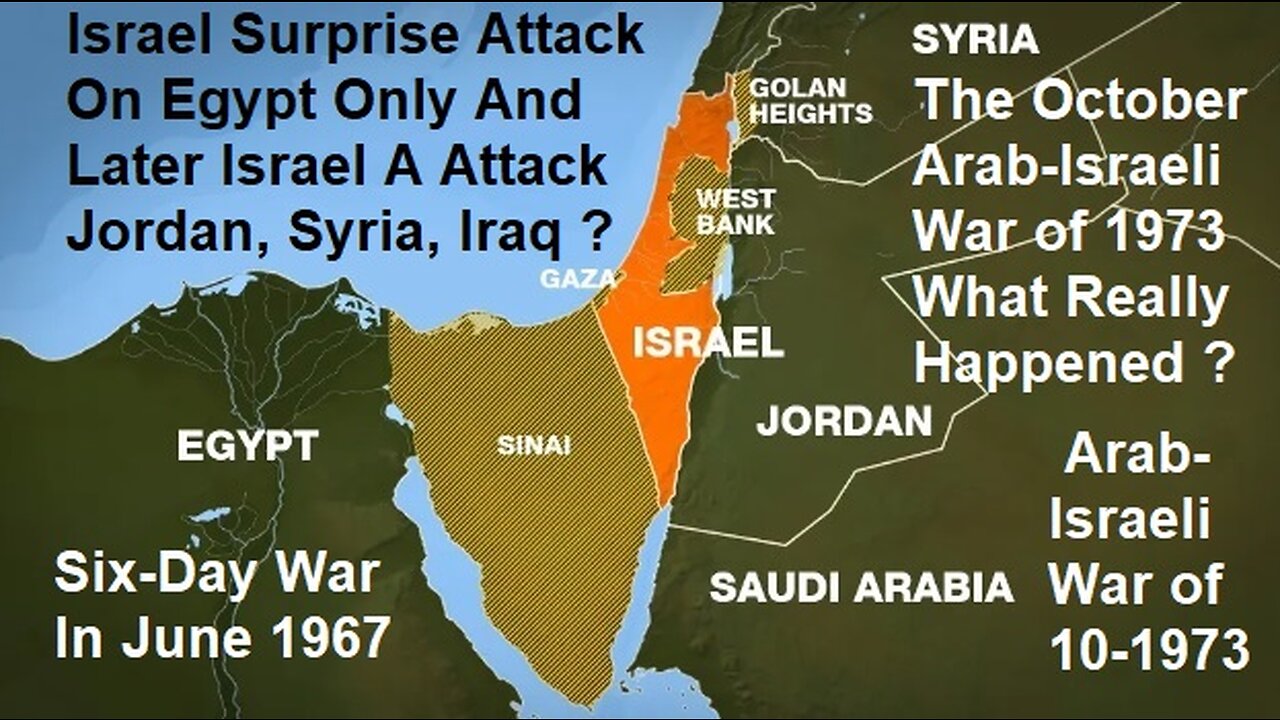Premium Only Content

Israel Surprise Attack On Egypt Only And Later Israel Attack Jordan, Syria, Iraq, Sinai
Israel Surprise Attack On Egypt Only June 1967 war was a critical development in the Arab-Israeli conflict, with consequences that are felt across the region to this day. It redrew the landscape of the conflict, expanded Israel’s territorial claims and confirmed its military dominance in the region.
This war, known to Israel as the Six-Day War and to Arabs as the June War and as the Naksa – the setback – came just two decades after the catastrophic events of 1948, or the Nakba, when the state of Israel was established and hundreds of thousands of Palestinians were expelled from their homes and land.
The War in June looks back at the events surrounding 1948, and the Suez Crisis in 1956, to understand the roots of the 1967 war. It explores the actual six days of battle in detail and then looks at the profound long-term consequences of this war.
Will Tell The Truth About All Surprise Attacked 2023 On Israel By Jihad Hamas Khilafah Islamic State and Israel Surprise Attacked 1967 On Egypt.
Six Day War, 1967. On the morning of June 5, Israeli planes surprise-attacked the at-rest Egyptian air force, destroying hundreds of planes. Similar strikes hobbled Jordan and Syria. On the ground, Israeli troops marched into the Sinai Peninsula and the Gaza Strip. They routed Palestinians from the West Bank of the Jordan River, seized the Golan Heights in Syria and continued on to the Suez Canal. The rapid chain of events altered the landscape and the future of the Middle East — and, arguably, foreign policy in state departments around the world.
Field Marshal Amer and the Egyptian top brass were meeting at Bir Tamada, an airbase in Sinai. They were just starting the meeting when the first Israeli jets started their bomb runs. One of the generals was so surprised by the attack that the first thing that flashed through his mind was a coup or some other kind of Egyptian betrayal.
Day Israel Surprise Attacked America U.S.A. 8 June 1967 On United States Navy Ship USS Liberty -Wow
The USS Liberty incident was an attack on a United States Navy technical research ship (spy ship), USS Liberty, by Israeli Air Force jet fighter aircraft and Israeli Navy motor torpedo boats, on 8 June 1967, during the Six-Day War. The combined air and sea attack killed 34 crew members (naval officers, seamen, two marines, and one civilian NSA employee), wounded 171 crew members, and severely damaged the ship. At the time, the ship was in international waters north of the Sinai Peninsula, about 25.5 nmi (29.3 mi; 47.2 km) northwest from the Egyptian city of Arish.
Israel apologized for the attack, saying that the USS Liberty had been attacked in error after being mistaken for an Egyptian ship. Both the Israeli and U.S. governments conducted inquiries and issued reports that concluded the attack was a mistake due to Israeli confusion about the ship's identity. Others, including survivors of the attack, have rejected these conclusions and maintain that the attack was deliberate.
In May 1968, the Israeli government paid US$3.32 million (equivalent to US$28 million in 2022) to the U.S. government in compensation for the families of the 34 men killed in the attack. In March 1969, Israel paid a further $3.57 million ($28.5 million in 2022) to the men who had been wounded. In December 1980, it agreed to pay $6 million ($21.3 million in 2022) as the final settlement for material damage to the ship plus 13 years of interest.
https://en.wikipedia.org/wiki/USS_Liberty_incident
Israeli jet fighters hit the vessel with rockets, cannon fire and napalm, before three Israeli torpedo boats moved in to launch a second more devastating attack. Though she did not sink, the Liberty was badly damaged. Thirty-four US servicemen and civilian analysts were killed, another 171 were wounded by attack had been a catastrophic accident.
Enemy array map of the 4th of July 1967 the Six Day War. A rare map depicting the array of the enemy forces on the eve of the Six Day War. A day before Israel decided to attack, the map shows the enormity if the Arab forces on three fronts which were a grave danger to the State of Israel. The IDF had no choice and went in an attack and conquered the enemy in order to give security to the Jewish people.
The Six-Day War: Background & Overview (June 5-10, 1967) Six Day War; Table of Contents | Battle Maps | “Myths & Facts” Israel consistently expressed a desire to negotiate with its neighbors. In an address to the UN General Assembly on October 10, 1960, Foreign Minister Golda Meir challenged Arab leaders to meet with Prime Minister David Ben-Gurion to negotiate a peace settlement. Nasser answered on October 15, saying that Israel was trying to deceive world opinion, and reiterating that his country would never recognize the Jewish State. (1) The Arabs were equally adamant in their refusal to negotiate a separate settlement for the refugees. As Nasser told the United Arab Republic National Assembly March 26, 1964: Israel and the imperialism around us, which confront us, are two separate things. There have been attempts to separate them, in order to break up the problems and present them in an imaginary light as if the problem of Israel is the problem of the refugees, by the solution of which the problem of Palestine will also be solved and no residue of the problem will remain. The danger of Israel lies in the very existence of Israel as it is in the present and in what she represents. (2) The Palestinian Army In 1963, the Arab League decided to introduce a new weapon in its war against Israel – the Palestine Liberation Organization (PLO). The PLO formally came into being during a 1964 meeting of the first Palestinian Congress. Shortly thereafter, the group began to splinter into various factions. Ultimately, the largest faction, Fatah, would come to dominate the organization, and its leader, Yasser Arafat, would become the PLO chairman and most visible symbol. All the groups adhered to a set of principles laid out in the Palestine National Charter, which called for Israel’s destruction. The PLO’s belligerent rhetoric was matched by deeds. Terrorist attacks by the group grew more frequent. In 1965, 35 raids were conducted against Israel. In 1966, the number increased to 41. In just the first four months of 1967, 37 attacks were launched. The targets were always civilians. (3) Most of the attacks involved Palestinian guerillas infiltrating Israel from Jordan, the Gaza Strip, and Lebanon. The orders and logistical support for the attacks were coming, however, from Cairo and Damascus. Egyptian President Nasser’s main objective was to harass the Israelis, but a secondary one was to undermine King Hussein’s regime in Jordan. King Hussein viewed the PLO as both a direct and indirect threat to his power. Hussein feared that the PLO might try to depose him with Nasser’s help or that the PLO’s attacks on Israel would provoke retaliatory strikes by Israeli forces that could weaken his authority. By the beginning of 1967, Hussein had closed the PLO’s offices in Jerusalem, arrested many of the group’s members, and withdrew recognition of the organization. Nasser and his friends in the region unleashed a torrent of criticism on Hussein for betraying the Arab cause. Hussein would soon have the chance to redeem himself. Terror from the Heights The breakup of the U.A.R. and the resulting political instability only made Syria more hostile toward Israel. Another major cause of conflict was Syria’s resistance to Israel’s creation of a National Water Carrier to take water from the Jordan River to supply the country. The Syrian army used the Golan Heights, which tower 3,000 feet above the Galilee, to shell Israeli farms and villages. Syria’s attacks grew more frequent in 1965 and 1966, forcing children living on kibbutzim in the Huleh Valley to sleep in bomb shelters. Israel repeatedly protested the Syrian bombardments to the UN Mixed Armistice Commission, which was charged with policing the cease-fire, but the UN did nothing to stop Syria’s aggression – even a mild Security Council resolution expressing “regret” for such incidents was vetoed by the Soviet Union. Meanwhile, Israel was condemned by the United Nations when it retaliated. While the Syrian military bombardment and terrorist attacks intensified, Nasser’s rhetoric became increasingly bellicose. In 1965, he announced, “We shall not enter Palestine with its soil covered in sand; we shall enter it with its soil saturated in blood. “(4) Again, a few months later, Nasser expressed the Arabs’ aspiration: “[el] the full restoration of the rights of the Palestinian people. In other words, we aim at the destruction of the state of Israel. The immediate aim: perfection of Arab military might. The national aim: the eradication of Israel. “(5) Syria’s attacks on Israeli kibbutzim from the Golan Heights finally provoked a retaliatory strike on April 7, 1967. During the attack, Israeli planes shot down six Syrian fighter planes – MiGs supplied by the Soviet Union. Shortly thereafter, the Soviets – who had been providing military and economic assistance to both Syria and Egypt – gave Damascus false information alleging a massive Israeli military buildup in preparation.
So Their 6,000,000 Jews That Never Existed - Started 18 years before Hitler assumed power?
The Six-Day War (Hebrew: מִלְחֶמֶת שֵׁשֶׁת הַיָּמִים, Milḥemet Šešet HaYamim; Arabic: النكسة, an-Naksah, lit. 'The Setback' or حرب 1967, Ḥarb 1967, 'War of 1967') or June War, also known as the 1967 Arab–Israeli War or Third Arab–Israeli War, was fought between Israel and a coalition of Arab states (primarily Egypt, Syria, and Jordan) from 5 to 10 June 1967.
Between 776 and 983 Israelis were killed and 4,517 were wounded. Fifteen Israeli soldiers were captured. Arab casualties were far greater. Between 9,800 and 15,000 Egyptian soldiers were listed as killed or missing in action. An additional 4,338 Egyptian soldiers were captured. Jordanian losses are estimated to be 700 killed in action with another 2,500 wounded. The Syrians were estimated to have sustained between 1,000 and 2,500 killed in action. Between 367 and 591 Syrians were captured.
Casualties were also suffered by UNEF, the United Nations Emergency Force that was stationed on the Egyptian side of the border. In three different episodes, Israeli forces attacked a UNEF convoy, camps in which UNEF personnel were concentrated and the UNEF headquarters in Gaza, resulting in one Brazilian peacekeeper and 14 Indian officials killed by Israeli forces, with an additional seventeen peacekeepers wounded in both contingents.
HEAT WAFTED UP IN SLEEPY SPIRALS from the Sinai Desert on the afternoon of October 6, 1973. Lizards lay about on sun-warmed stones, blinking in contentment. Falcons circled lazily in the pale blue sky. The waters of the Suez Canal lapped gently at its sandy shores. Suddenly, at exactly 2 p.m., this hushed stillness erupted as 2,000 Egyptian artillery pieces, Katyusha rockets, howitzers, and surface-to-surface missiles blasted the canal’s eastern bank, throwing tremendous plumes of sand into the air. Israeli defensive positions years in the making were pulverized in minutes. Without warning, 222 Egyptian MiG and Sukhoi fighters came screaming out of the sky and bombed command posts, surface-to-air batteries, air bases, supply dumps, and radar installations. Simultaneously, a few hundred miles to the north, the rugged hills of the Golan Heights shook with massive explosions as 100 Syrian MiGs attacked Israeli positions and an assault force of as many as 900 tanks and 40,000 infantry crossed into Israeli territory.
The October War had begun. Before it was over, battalions of tanks, hundreds of aircraft, and legions of soldiers would clash in one of the late 20th-century’s most momentous wars. Oil prices would soar to unprecedented heights, and the specter of nuclear war would loom over the battlefield. Though brief—fighting ended within a month—the conflict had enormous impact. It broke a political stalemate and made possible a long Egyptian-Israeli peace that’s unique in the roiling Middle East.
‘I’ll wipe them out with two tanks,’ an Israeli general said.
The Arab-Israeli War of 1973: Honor, Oil, and Blood On October 6, 1973.
The roots of the fighting in 1973 lay in the Six-Day War of June 1967, when the Israel Defense Forces (IDF) trounced combined Arab armies and took the Golan Heights from Syria, the Sinai Peninsula from Egypt, and East Jerusalem from Jordan. The so-called War of Attrition followed, with artillery duels, commando raids, air strikes, and diplomatic forays, none of which shook Israel’s grip on its newly occupied territories. Stymied, Egyptian president Anwar el-Sadat determined to retake the lost lands with another war. Sadat went to Syrian president Hafez el-Assad, who burned to recapture the Golan Heights. “I’ll be with you,” he told Sadat. Jordan and Iraq agreed to provide a few military units.
Sadat, a talented politician and soldier who had succeeded longtime president Gamal Abdel Nasser in 1970, determined he had no choice but to fight. Israel would negotiate on the occupied lands only if threatened militarily, he thought. And he knew that if he made peace without a fight, Saudi Arabia and other rich Arab states would cut off much-needed development aid to Egypt.
SADAT DID NOT SET OUT TO DESTROY Israel. The IDF was too strong, and the United States would never let its ally fall. Rather, he wanted to deliver a blow that would shake the IDF’s sense of invincibility—inflated by its quick victory in the 1967 war—and persuade Israel and its allies that the negotiating table offered the best chance for security. “If we could recapture even four inches of Sinai territory,” he reasoned, “then the whole situation would change—east, west, all over.”
Operationally, Sadat believed he had to hit hard and fast. Once hostilities opened, the United States and the Soviet Union would almost certainly get involved—the Americans to protect Israel, and the Russians to help Syria and maintain its influence in the region. Sadat also assumed the United Nations would insist on a cease-fire. The key, he believed, was to quickly retake as much land as possible to give Egypt a strong bargaining position in negotiations that would undoubtedly follow. “He who wins the first 24-hour encounter,” Sadat said, “will surely win the entire war.”
The Egyptians and Syrians designed a two-front operation, coordinated from Cairo. As the Egyptians stormed across the Suez Canal and occupied part of the Sinai, Syrian forces would move to retake the Golan Heights. Military leaders for the two countries tapped the Soviet Union for help constructing the world’s most formidable surface-to-air defense systems, with SAM-2, -3, -6, and -7 missile batteries. They bought thousands of rocket-propelled grenade launchers and AT-3 Saggers, wire-guided antitank missiles. Soviet T-55s and T-62s were added to the tank battalions, while air power was bolstered by MiG-17, -21, and -23 fighters and Su-7 and -20 fighter-bombers, as well as Scud surface-to-surface missiles.
Egyptian soldiers trained intensely, rehearsing their attack across the Suez at least 35 times with full-scale mockups of Israeli installations. Sadat’s chief of staff, Lieutenant General Saad el-Shazly, focused on what he called “the harshest test”: crossing the Suez Canal, which was as wide as 220 yards in places, and breaking through ramparts that IDF engineers had built on the other side. These mountains of sand topped 60 feet and had slopes of 45 to 65 degrees. To carve out passages for their men and machines, the Egyptians created some 40 engineering battalions equipped with 450 high-powered water hoses.
The Arabs would face an Israeli military feared for its armor and air power. On the ground, IDF forces were headed by well-armored Centurion and M-60 tanks as well as “Super Shermans,” revved-up versions of the World War II classic with 75mm or 105mm high-velocity cannons. In the air, the Israeli Air Force, which totaled 366 craft, boasted of its superb F-4 Phantoms, A-4 Skyhawks, Mirages, and Super-Mystères.
Since the 1967 war, Israel had built formidable defenses for its new territories. The Bar-Lev Line, a chain of fortifications, stretched 100 miles along the Suez, from the Mediterranean in the north to the Gulf of Suez in the south. In the Golan Heights, an intricate network of antitank trenches, firing platforms, and listening posts defended Israeli lands.
The IDF felt secure behind these barriers—perhaps too secure. Before the Egyptian attack, less than half of the Bar-Lev defenses were manned fully. Strutting with confidence after the Arab collapse in the 1967 war, Israel’s military leaders underestimated their foes. “Put all [the Arabs’] paratroops with Saggers on a hill,” one major general crowed, “and I’ll wipe them out with two tanks.” Zvi Zamir, head of Mossad, Israel’s secret service, later admitted: “We scorned them.”
Throughout the summer and early autumn of 1973, Egyptian and Syrian military leaders finalized their plans. They decided to open the attack on October 6, when the Suez Canal’s currents and tides would be optimal for a crossing. This would also be Yom Kippur, the holiest day for Jews. (Historians disagree about whether Egypt deliberately scheduled the attack for this sacred day.) Jews and many in the West refer to the conflict as the Yom Kippur War. Arabs call it the Ramadan War because the fighting opened during the holy month of Ramadan and on the very day when Muslims feast to celebrate the Prophet Muhammad’s victory at the Battle of Badr and his return to Mecca. Indeed, the Egyptians code-named their attack Operation Badr.
Israel remained largely unaware of the Arab plan, thanks to a brilliant campaign of deception. Because the Syrians did little to conceal their military buildup, the IDF was convinced that it was of no consequence. Egypt’s movements seemed little different than its annual autumn military exercises.
To add to the misdirection, Egyptian and Syrian leaders whispered to the press about deep rifts dividing their two countries as Sadat made blustery speeches about a “year of decision” that never seemed to come.
As the Arab buildup began to look like a real threat, some Israeli officials urged a preemptive strike. Defense Minister Moshe Dayan and Prime Minister Golda Meir balked, worried that Israel would be seen as the aggressor—a perception that might jeopardize support from the United States. “War is imminent,” Mossad spies reported on October 5, but the head of Israeli military intelligence dismissed the warning. Later it emerged that Jordan’s King Hussein, who feared all-out war, had told Meir of the coming assault. Again, little was done. Dayan and Meir expected an attack, but not the military, political, and economic war that the Arabs had prepared.
THE ATTACK ON THE SINAI OPENED with brutal force and painstaking precision. In the first minute after the 2 p.m. start, Egyptian artillery slammed more than 10,000 shells onto Israeli positions along the Suez Canal. Within 20 minutes, Egyptian MiGs had completed as many as 300 sorties. Dinghies with assault troops sliced through the canal’s waters, the men chanting “Allahu akbar!” (“God is the greatest!”) at each stroke. Engineers deploying water hoses, bulldozers, and explosives blasted some 60 paths through the sand ramparts.
By 5 o’clock, some 32,000 infantry had landed. Within 24 hours, more than 1,000 tanks, 13,500 vehicles, and 100,000 men were safely across the canal. “The whole operation,” Shazly remarked, “was a magnificent symphony played by tens of thousands of men.” Egypt’s losses: just 208 killed.
In the Golan Heights, the Syrians looked poised for similar success. They had placed about 1,300 tanks (mostly T-55s), 65 SAM batteries, 400 antiaircraft artillery, and 600 artillery pieces along a 50-mile front. By contrast, the IDF had just 170 tanks and 60 artillery pieces to defend the region.
Geographically, the boundaries of the Golan were roughly marked by Mount Hermon in the north and the Sea of Galilee in the southwest. Syrian forces were to attack in both the north and south, preceded by an air strike. Troops in the north aimed to smash a hole in Israeli lines and then arc down to link up with the southern forces, snapping off the Golan in a pincer movement. In the south, two Syrian infantry divisions were to strike near Rafid, while an armored division broke through Israeli defenses and captured key bridges spanning the Jordan River at Benot Ya’akov and Arik, just north of the Sea of Galilee.
In the north, commandos of the elite 82nd Parachute Regiment initiated the attack, landing on Mount Hermon and capturing a critical Israeli observation post. Fortunately for the Israelis, however, Syrian forces were not the equal of the Egyptians. Their officers failed to bring forward engineering units with the bridge equipment to cross Israeli antitank ditches. A massive traffic jam resulted. As the Syrians sorted things out, Israeli artillery and tank fire from the excellent 188th “Barak” Armored Brigade knocked out their forward units, blunting the advance.
After heavy losses, the Syrians finally crossed the ditches on October 7 and charged furiously at enemy forces positioned on the high ground. The Israelis rained fire upon the infantry in the valley below, cutting them to pieces. Similarly, Syrian armor rushed ahead with no coordination, presenting fat targets for Israeli flanking attacks and artillery fire.
Three days into the fighting, the Syrians in the northern Golan threw more than 200 tanks, additional artillery, and the Republican Guard against some 30 Israeli tanks of the elite 7th Armored Brigade, part of Brigadier General Rafael Eitan’s command. Through skillful counterattacks, this tiny Israeli force confused the Syrians, many of whom abandoned their equipment and fled. High-explosive, armor-piercing shells rent many of the Syrian tanks that stood their ground. Red-orange flames shot skyward, and plumes of black smoke curled into the air from the smashed hulks of more than 500 Syrian tanks and armored personnel carriers, along with 60 to 80 Israeli tanks and other equipment. The attack in the north had been stopped cold in what became known as the Valley of Tears.
In the southern Golan, the Syrians enjoyed some early success. By the end of the first day, their sheer numbers had forced a breakthrough. Though snarled traffic slowed the advance as it had in the north, the Syrians plowed forward, heading for Hushniya, northeast of the Sea of Galilee, and even attempting to take Nafekh, the Israeli command center.
On the second day, Syrian commanders in the south targeted the Benot and Arik bridges—key routes for Israeli reinforcements. But problems soon mounted. A Syrian mechanized brigade ran into a small IDF force of Super Shermans, losing 17 T-55s. A halt was called.
Meanwhile, 35 tanks of a Syrian armored brigade were put out of action before the Arik Bridge just as another mechanized brigade got into a firefight in the same sector. Again, this brigade stopped abruptly. In the late afternoon, 95 Syrian T-62s were advancing virtually unopposed when their commander, for reasons never determined, ordered them to stop as well. Such appalling Syrian command and control—combined with superb Israeli gunnery—doomed the southern operation.
THE SUCCESS OF ISRAELI FORCES IN THE GOLAN was not happenstance. Though the Arab attack surprised them, Israeli leaders reacted swiftly and decided to concentrate forces against the Syrians first; if defenses broke in the Golan, they reasoned, the Syrians would reach inside Israel itself. The Egyptian thrust could be contained in the vast Sinai, a natural buffer, until the Syrians had been halted.
Meanwhile, Egyptian operations in the Sinai were going well. With the Bar-Lev forts silenced, the Egyptians consolidated their position, laying minefields and constructing defensive and interlocking firing positions for their tanks and artillery. The antiaircraft and SAM missile shield covered ground operations, a stinging surprise for the Israeli Air Force, which lost 14 planes in the first two days.
The Egyptians also proved to the doubting Israelis that they had the stomach to fight. Without waiting for air or infantry support, the IDF counterattacked on October 8, sending 300 tanks in a headlong dash against the Egyptians, expecting the enemy to break and run as they had done in previous wars. To the Israelis’ shock, the Egyptians hit them from the front with artillery fire, from the sides with tank assaults, and from behind with infantry wielding Saggers and rocket-propelled grenade launchers. In 48 hours, 200 Israeli tanks were destroyed.
The Egyptians’ will and tactics stunned the Israelis. One Israeli officer recounted how he mistook enemy soldiers atop sand dunes for trees: “One of my tank commanders radioed back, ‘My God, they’re not tree stumps. They’re men!’…Suddenly all hell broke loose. A barrage of missiles was being fired at us. Many of our tanks were hit. We had never come up against anything like this before.”
Major General Ariel Sharon recalled: “These were soldiers who had been brought up on victories….It was a generation that had never lost. Now they were in a state of shock….How was it that [the Egyptians] were moving forward and we were defeated?”
The situation quickly became critical for Israel. In the first four days of the fighting, it lost 49 warplanes and almost 500 tanks. Panic swept through the Israeli government; unless the Egyptians could be turned, the entire country was at risk. In an October 9 meeting with Prime Minister Meir, Dayan discussed using the country’s nuclear arsenal—at least 13 bombs deliverable via Jericho missiles. Unwilling to deploy this ultimate weapon, Meir demanded American help. President Richard Nixon was sympathetic—his national security adviser and secretary of state, Henry Kissinger, believed that the defeat of Israel by a Soviet-armed Syria would be a geopolitical disaster—and approved $2.2 billion in supplementary military aid. The U.S. Air Force launched Operation Nickel Grass, which would airlift some 22,000 tons of jet aircraft, tanks, ammunition, and other equipment to Israel. Another 33,000 pounds of materiel arrived by sea. This was more than military aid; it was life support.
EVEN BEFORE THIS HELP ARRIVED, RESOURCEFUL Israeli commanders changed tactics. Instead of launching head-on assaults, they struck at the enemy’s flanks and used heavy machine guns to knock out infantry armed with antitank weapons. Soon, the Egyptian advance slowed and stopped. But already parts of the army had pushed as far as nine miles into the Sinai. Sadat had won his “four inches of territory.”
At this moment, the war took a dramatic turn as Sadat’s preparations with his allies paid off. Before the war, he had secured an agreement from Saudi Arabia and other oil-producing Arab countries to limit exports to nations that didn’t support the Arab cause. In accordance with that agreement, and with the announcement of Operation Nickel Grass, they now slapped an embargo on oil exports to the United States and Europe.
This rocked world oil markets. During the 1967 war, Arab countries had made a half-hearted effort to stop sales to the West; this time, they fully committed. The price of oil quadrupled to nearly $12 per barrel by 1974. Sadat’s play was geopolitical strategy at its finest; Arab countries for the first time turned their vast oil reserves into a powerful political weapon, a tactic they would repeat for decades to come.
By October 10, four days into the fighting, the Golan Heights was a graveyard of steel. Some 870 Syrian tanks, hundreds of artillery pieces, and thousands of other vehicles smoldered across the rocky ravines strewn with corpses. Sensing that the Syrian offensive had lost steam, the Israelis counterattacked on the 11th. Brigadier General Moshe Peled, commander of the 146th Reserve Armored Division, struck from the south with about 110 tanks and a mechanized infantry brigade, while the 240th Reserve Division under Brigadier General Dan Laner attacked in the center. The Israelis punched a hole in the Syrian line and roared east, taking the Syrians from behind and effectively wiping out an infantry and armored brigade.
With that, almost all the Syrians’ territorial gains were lost. The Israelis now invaded Syria itself, hoping to move within artillery range of Damascus and bring the war home to the Syrian leadership. Virtually unopposed, Israeli warplanes hit strategic sites inside the country. An armored division joined up with the 240th and pushed toward Damascus, while the 146th protected their flanks on the Jordanian frontier.
The Israelis came within roughly 25 miles of Damascus. Retreating before this onslaught, the Syrians made a stand on the second of three defensive lines built in the years after 1967. Fighting on their own soil, they were tenacious. An Iraqi armored division appeared—part of the force promised Sadat before the war—and smashed into the right flank of the IDF’s 240th Armored Division. The Israelis wheeled to deal with this threat, which grew more serious when the Iraqis were joined by an armored brigade sent by Jordan. The Israeli advance halted, but they had recaptured Mount Hermon and now stood close enough to shell Damascus.
AS THINGS FELL APART TO THE NORTH, SADAT felt compelled to order an offensive and press deeper into the Sinai. Shazly, his chief of staff, and other top generals fiercely opposed this move. They remembered how Israeli planes had devastated Arab ground forces in the 1967 war, and they did not want to move the army from under its missile shield. Yet on October 14, as many as 1,000 Egyptian tanks and several mechanized brigades rumbled forward. The targets were two gateways into Israel: the mountain passes at Mitla and Giddi, both at least 30 miles east of the Suez.
This thrust was met by air strikes as well as some 800 tanks led by heroes of Israel’s previous wars—General Avraham Adan and Major General Sharon. The two armored divisions outflanked the Egyptian units and ripped into them, destroying 265 tanks and at least 200 other vehicles. In contrast, only 40 Israeli tanks suffered damage, most of it minor. Worse for the Egyptians, the Israeli assault opened a chink in their lines along the Great Bitter Lake, which lay north of the Gulf of Suez. Adan and Sharon pounced and launched a counteroffensive to bridge the Suez Canal and divide the Egyptian Second and Third Armies on the west bank. Sharon was to boldly move his forces across the canal and push the Second Army north, establishing a corridor for Adan’s men to cross and wheel south, where they would destroy SAM missile launch sites and hit the Egyptian Third Army from the rear.
On October 15 and 16, Sharon’s 143rd Reserve Armored Division crossed the canal on pontoon bridges and established a bridgehead. The Israelis also raced southeast on the Sinai, slamming into the Egyptians concentrated in an area known as the Chinese Farm.
The fighting here was fierce. For four days the Egyptians fought the Israelis off from behind well-prepared defenses but Adan crushed their counterattacks. The Egyptian 25th Armored Brigade, for instance, lost its entire force of armored personnel carriers and 85 of its 96 T-62s while destroying only three IDF tanks.
On October 17 or 18, Soviet officials showed Sadat and General Ahmad Ismail Ali, his war minister, satellite pictures of the expanding bridgehead that Sharon had established on the west bank of the Suez. General Shazly recommended pulling back four armored units from the Sinai to counter the threat. But Sadat, calculating the political need to hang on to Egyptian gains, ruled against a withdrawal.
Three days later, with the Israeli threat deepening, Sadat finally pushed for an end to the war. “I knew my capabilities,” he said later, noting the American aid to Israel. “I did not intend to fight the entire United States of America.” Kissinger flew to Moscow, where he and Soviet leader Leonid Brezhnev drafted a U.N. Security Council resolution calling for a cease-fire.
Although Egyptian and Israeli officials accepted the truce, fighting continued. The IDF sensed a crushing victory and marched on. Having crossed the Suez through the corridor that Sharon had established, General Adan and his 200 or so tanks raced south, destroying SAM sites and enveloping the 45,000-man Egyptian Third Army.
Some Israelis wanted to destroy the force, which was cut off from food and water supplies. Sadat requested U.S. and Soviet troops to enforce the cease-fire, shrewdly drawing the two superpowers into the fray. When the Americans hesitated, Brezhnev signaled that the Soviet Union was willing to act unilaterally—a message that the United States interpreted as major threat. Kissinger and a special crisis-management team within the White House held an emergency meeting and raised U.S. military forces from Defense Readiness Condition 4 to 3 for the first time since the 1962 Cuban Missile Crisis. Ultimately, diplomacy defused the situation, but it was one of the Cold War’s most dangerous moments.
On October 28, Israel, under pressure from the United States, agreed to allow the Egyptians to deliver food and medical supplies to the trapped Third Army. The next day, Syria stopped fighting. A couple of weeks later, on November 11, Egypt and Israel agreed to a cease-fire drafted by Sadat and Kissinger. Syria refused to sign.
IT WAS A MESSY END to a savage war. The armor clashes had been the largest since World War II and remain some of history’s costliest. The casualty counts for Egypt and Syria topped 60,000, with more than 2,000 tanks destroyed. Though Israel saw losses of fewer than 12,000 men, the Arab attacks had delivered a body blow to its military might. By one estimate, the war cost Israel the equivalent of its gross national product for a year. In the Sinai alone, the Egyptians had destroyed 110 helicopters and aircraft, about a quarter of Israel’s air power.
Israel’s psyche suffered perhaps the greatest damage. While the IDF had won militarily, the Arabs had seriously threatened Israel in the war’s opening days and proved its leaders wholly unprepared for war. A special commission fingered top leaders in both the IDF and the intelligence service, and fallout from the war helped push Meir from power in 1974, along with Dayan.
The Arabs still today see the war as a glorious struggle against unfair odds, a grand fight to reclaim lost honor. Calling it “a victory which cannot be erased,” Sadat declared, “Egyptian armed forces have realized a miracle.” The Egyptian president emerged a hero and a political figure with great international influence. He had destroyed the myth of Israeli invincibility, restored national pride, ensured financial support from Saudi Arabia and other oil-rich Arab states, successfully played the superpowers, and set the grounds for Egyptian-Israeli negotiations on the Sinai. He was, said Henry Kissinger, a great man “who had the wisdom and courage of the statesman and occasionally the insight of the prophet.”
In 1977, Sadat visited Israel—previously unthinkable for an Arab leader—and made a landmark proposal for peace. This led to the 1978 Camp David accords, brokered by U.S. President Jimmy Carter, and a treaty the next year through which Egypt regained the Sinai and the Suez Canal and made peace with Israel. For this bold action, Sadat and Israeli leader Menachem Begin were awarded the Nobel Peace Prize. (Carter won the Nobel the next year for his overall efforts on peace.)
Even as the world cheered Sadat, many Arabs branded him a traitor for not linking peace with Israel to a larger settlement that included the rights of Palestinians and the return of other Arab lands conquered by Israel in 1967. In 1981, radical Islamists assassinated him during a military parade celebrating the October War.
Impressive in scope, unique in execution, the October War stands as one of the most influential conflicts of the second half of the 20th century. The last of the great Arab-Israeli wars, it was the first international conflict where oil was pivotal. It heralded a new order not only in the Middle East but also in the global political and economic system.
Here is a review of casualties in Middle East conflicts since World War II:
GULF WAR, JAN. 17-FEB. 28, 1991: To date, the allies have reported 178 killed in action. No comprehensive Iraqi casualty figures have been issued, but an Iraqi official was quoted as saying 20,000 Iraqis were killed in the first 26 days of the war. Other estimates have put the number of Iraqi dead in the tens of thousands.
IRAN-IRAQ WAR, 1980-88: Iran has acknowledged 135,000 military and civilian dead, but Western military analysts put the figure two or three times higher. Iraq has not issued figures, but diplomats in Baghdad estimate at least 100,000 dead. Conservative Western estimates put casualties on both sides at 1 million dead or wounded.
SOUTH YEMEN CIVIL WAR, JANUARY, 1986: Officials put the death toll at nearly 4,250, but diplomatic sources said the figure was nearer 10,000.
ISRAELI INVASION OF LEBANON, 1982: Israel had 657 killed and 3,887 wounded. Syrian casualties were 370 killed and 1,000 wounded. The PLO had an estimated 1,000 killed with 6,000 captured. More than 19,000 Lebanese and Palestinians, mostly civilians, were killed and 30,000 wounded.
LEBANESE CIVIL WAR, 1975-90: An estimated 150,000 people killed. More than 1 million, a quarter of the population, were displaced.
ARAB-ISRAELI WAR, 1973: Israeli casualties were 2,569 killed and 7,500 wounded in the three-week conflict. Syria lost an estimated 3,500 dead, with 21,000 wounded. Egypt had an estimated 15,000 killed and 30,000 wounded. Iraqi casualties were 125 killed and 260 wounded.
JORDAN’S WAR WITH THE PLO AND SYRIA, 1970: Jordan had 600 killed, 1,500 wounded; Syrian casualties were 600 killed or wounded, and 10,000 Palestinians were killed or wounded.
ARAB-ISRAELI WAR OF ATTRITION, MARCH, 1969-AUGUST, 1970: Israel had 721 killed and 2,659 wounded. Arab casualties are not known, but at the peak of the fighting, Egypt alone had 300 casualties a day.
SIX-DAY ARAB-ISRAELI WAR, 1967: Egypt lost an estimated 11,500 killed and 10,000 taken prisoner, including nine generals, in the six days of combat. Syrian casualties were 1,000 killed and Jordan lost 6,094. Israel casualties were 777 killed and 2,811 wounded.
YEMEN CIVIL WAR, 1961-1969: Figures vary, but an estimated 70,000 Yemenis and Egyptians, who supported republican rebels against the royalists, were killed or wounded.
ISRAEL’S SINAI CAMPAIGN, 1956: Israel lost 172 killed, 817 wounded. Egyptian casualties were an estimated 2,000-3,000 dead. British and French casualties in the invasion of Suez, which coincided with Israel’s thrust into the Sinai desert, were 82 killed and 129 wounded.
ARAB-ISRAELI WAR, 1948-49: Israel lost 6,200 killed, and Arab losses were estimated at 2,000 regular soldiers killed. Thousands of Arab and Palestinian irregulars were also believed killed.
The 1967 US-Arab-Israeli War marked the failure of the Eisenhower, Kennedy, and Johnson administrations’ efforts to prevent renewed Arab-Israeli conflict following the 1956 Suez War. Unwilling to return to what National Security Advisor Walter Rostow called the “tenuous chewing gum and string arrangements” established after Suez, the Johnson administration sought Israel’s withdrawal from the territories it had occupied in exchange for peace settlements with its Arab neighbors. This formula has remained the basis of all U.S. Middle East peacemaking efforts into the present.
President Lyndon Johnson and his advisors meet with Israeli Foreign Minister Abba Eban to discuss the developing crisis in the Middle East, May 26, 1967. (LBJ Library photo by Yoichi Okamoto)
The Johnson Administration and the Arab-Israeli Conflict, 1963–1967
Lyndon Johnson’s presidency witnessed the transformation of the American role in the Arab-Israeli conflict. Until the early 1960s, the United States had adhered to the terms of the Tripartite Declaration of 1950, wherein the United States, United Kingdom, and France had pledged to prevent aggression by Middle Eastern states and oppose a regional arms race. The United States had pressed Israel to withdraw from the Sinai Peninsula and Gaza Strip after Suez, and rejected Israeli requests for all but limited quantities of defensive weapons. By the time Johnson took office, however, U.S. policymakers concluded that this policy was no longer sustainable. Soviet arms sales to left-leaning Arab states, especially Egypt, threatened to erode Israel’s military superiority. Johnson’s advisors worried that if the United States did not offset this shift in the balance of power, Israel’s leaders might launch a preventive war or develop nuclear weapons.
Initially, the Johnson administration sought to convince Egyptian President Gamal Abdul Nasser and the Soviet leadership to work toward a regional arms control regime, but neither party proved receptive. Thus, in 1965, Johnson agreed to sell Israel M48A3 tanks, followed by A–4 Skyhawk aircraft in 1966. The rationale behind these sales, as National Security Council staffer Robert Komer put it, was that “Arab knowledge that they could not win an arms race against Israel should contribute long-term to the damping down of the Arab-Israeli dispute.”
However, U.S. efforts to preserve the regional balance of power were soon undermined by Fatah and other Palestinian guerilla organizations, which began attacking targets inside Israel. The Johnson administration tried to intercede with Fatah’s Syrian patrons and to prevent Israeli retaliation against Jordan, from which most Palestinian raids were launched. U.S. officials worried that Israeli reprisals could undermine Jordan’s King Hussein, who had secretly agreed to keep Jordan’s strategically crucial West Bank a buffer zone. In November 1966, when the Israelis attacked the West Bank town of Samu‘ , the Johnson administration voted for a United Nations Resolution condemning Israel, admonished Israeli officials, and authorized an emergency airlift of military equipment to Jordan.
While the administration’s response to Samu‘ helped prevent further Israeli reprisals against Jordan, it failed to address the underlying problem of Palestinian cross-border attacks. By the spring of 1967, the Israelis were retaliating forcefully against Syria, whose leaders demanded that Egypt intervene on their behalf.
The Prewar Crisis
On May 13, 1967, Soviet officials informed the Syrian and Egyptian Governments that Israel had massed troops on Syria’s border. Though the report was false, Nasser sent large numbers of Egyptian soldiers into the Sinai anyway. On May 16, Egypt demanded that the United Nations Emergency Force (UNEF), which had been deployed in the Sinai Peninsula and the Gaza Strip since 1957, withdraw from Israel’s border. Secretary-General U Thant replied that he would have to withdraw UNEF from all its positions, including Sharm al-Shaykh, which would put political pressure on Nasser to close the Straits of Tiran to Israeli shipping. Nasser remained adamant, and on May 22, after UNEF withdrew, he announced that he would close the Straits. In 1957, President Dwight D. Eisenhower had promised that the United States would treat the closure of the Straits as an act of war. Johnson now had three unwelcome options: to renege on Eisenhower’s promise, acquiesce in an Israeli attack on Egypt, or order U.S. forces to reopen the waterway.
Instead, the President played for time. He sought international and Congressional support for Operation Red Sea Regatta, which called for a coalition of maritime nations to send a “probing force” through the Straits if Egypt refused to grant all nations free passage through them. Simultaneously, Johnson implored the Soviets to intercede with Nasser and urged Israeli restraint. “Israel,” Johnson told Israeli Foreign Minister Abba Eban on May 26, “will not be alone unless it decides to go it alone.” Yet over the following week, the administration failed to gain domestic or foreign backing for “Regatta.” Meanwhile, Jordan joined the Arab coalition, heightening the pressure for an Israeli strike. Though Johnson continued to caution Israel against preemption, a number of the President’s advisors had concluded that U.S. interests would be best served by Israel “going it alone” by the time the Israelis actually did so.
The War and its Aftermath
Between June 5 and June 10, Israel defeated Egypt, Jordan, and Syria and occupied the Sinai Peninsula, the Gaza Strip, the West Bank, East Jerusalem, and the Golan Heights. From the beginning, the United States sought a ceasefire in order to prevent an Arab defeat bad enough to force the Soviet Union to intervene. U.S. officials were also concerned about alienating pro-Western Arab regimes, especially after Egypt and several other Arab states accused the United States of helping Israel and broke diplomatic relations. Yet after June 5, the administration did not also demand an immediate Israeli pullback from the territories it had occupied. U.S. officials believed that in light of the tenuous nature of the prewar armistice regime, they should not force Israel to withdraw unless peace settlements were put into place.
The administration’s concept of “land-for-peace” solidified following the war. “Certainly,” Johnson proclaimed, “troops must be withdrawn; but there must also be recognized rights of national life, progress in solving the refugee problem, freedom of innocent maritime passage, limitation of the arms race, and respect for political independence and territorial integrity.” Yet after the Arab states rejected a Latin American UN resolution calling for full withdrawal in exchange for recognition of “the right of all states in the area to live in peace and security” and a similar U.S.-Soviet draft, the Johnson administration scaled back its efforts to promote a settlement. Though alarmed by Israeli decisions to absorb East Jerusalem and establish Jewish settlements in the occupied territories, U.S. officials believed that the Arabs remained too inflexible to justify pressing Israel to withdraw.
The Johnson administration did not re-enter the diplomatic fray until October, when the Soviets began to circulate a new version of the resolution that they had promoted that summer. Knowing that Israel would reject the Soviet draft, the administration encouraged the United Kingdom to introduce an alternative resolution devised by UN Ambassador Arthur Goldberg. Security Council Resolution 242, adopted on November 22, called for Israel’s withdrawal from “territories occupied in the recent conflict” in exchange for “termination of all claims or states of belligerency and respect for and acknowledgment of the sovereignty, territorial integrity and political independence of every State in the area and their right to live in peace within secure and recognized boundaries free from threats or acts of force.” Interpreted differently by Israelis and Arabs, this resolution would nonetheless remain the bedrock of all subsequent U.S. efforts to resolve the Arab-Israeli dispute.
The Arab Israeli conflict, from the 1936 revolt to 2023 A timeline of the main conflicts that saw Israel fight multiple wars against Arab countries and Palestinian groups since the establishment of the Jewish state in 1948.
Israel has pounded the Gaza Strip for a third day in a row and announced a “total” blockade of the already besieged Gaza Strip, including a ban on food and water, after Hamas carried out the biggest attack on the country in decades.
The Israeli army says some 100,000 reserve troops have amassed near the fence with Gaza, with over 3,000 injured and 687 killed in Gaza, 90 injured nad 17 killed in the Occupied West Bank, and 2,243 injured and over 800 killed in Israel.
The 1936–1939 Arab revolt in Palestine
The Great Palestinian Revolt was a popular nationalist uprising by Palestinian Arabs in Mandatory Palestine against the British administration of the Palestine Mandate, demanding Arab independence and the end of the policy of open-ended Jewish immigration and land purchases with the stated goal of establishing a “Jewish National Home”. The uprising coincided with a peak in the influx of immigrant Jews, some 60,000 that year – the Jewish population having grown under British auspices from 57,000 to 320,000 in 1935 – and with the growing plight of the rural fellahin rendered landless, who as they moved to metropolitan centers to escape their abject poverty found themselves socially marginalized.
1948 Arab Israeli war
After the State of Israel was sanctioned in what was then British Mandatory Palestine, by the United Nations (1947) war broke out between Palestinians and Jewish militias led by the Haganah, which later became the Israel Defence Forces. Egypt, Syria, Iraq, Lebanon and Transjordan (later Jordan) declared war on Israel on May 15, 1948, a day after it declared its independence. The war formally ended almost a year later leaving Israel controlling much of the former British Mandate, Egypt in control of Gaza, Jordan in control of the West Bank, and several hundred thousand Palestinians displaced.
1956 Suez Crisis
After Egyptian leader Gamal Abdel Nasser nationalise the Suez Canal, Israel invaded the Egyptian Sinai Peninsula on October 29 together with France and Britain, who sought control of the trade passing through the Suze. The attack was brought to a halt under US and Soviet pressure.
1967 Six Day War
In the wake of regional tensions as Israel confronted assaults by Palestinian militants based in Syria, Lebanon and Jordan, on June 5, Israel launched pre-emptive attacks on Egypt, Syria and Jordan in response to a build-up of force in the Sinai and the closure of the Suez Canal to Israeli shipping. Israel won a crushing victory by June 10, leaving it in control of Sinai, the West Bank, Gaza and the Golan Heights as well as more than 1 million Palestinians in the newly occupied territories.
1973 Yom Kippur War
Israel was caught out in a surprise offensive on October 6 by Egypt and Syria on the eastern banks of the Suez Canal. Saudi Arabia led an oil boycott in support of the war effort. Israel retained control of the Sinai peninsula, but the war led to negotiations and the signing of the Camp David peace accords in 1979.
1978 invasion of Lebanon
Following attacks by the Palestine Liberation Organisation – which had relocated to Lebanon from Jordan after taking part in a civil war there - Israel invaded southern Lebanon in March. It withdrew in a week after forcing the PLO away from the border.
1982 invasion of Lebanon
Israel invaded Lebanon again after cross-border clashes with the PLO. The invasion led to the siege of Beirut and the exile of the PLO’s leadership to Tunisia. Israel then occupied southern Lebanon for almost two decades.
Yitzhak Rabin, Bill Clinton, and Yasser Arafat during the Oslo Accords on 13 September 1993
1987 Palestinian Intifada
In what was described as Israel’s biggest intelligence failure since the 1973 war, protests broke out across the West Bank and Gaza that developed into a sustained uprising lasting several years. The intifada prompted US and Norwegian mediation that led to the 1993 Oslo Accords between Israel and the PLO.
1996 Lebanon war
On April 11, Israel launched a big offensive against the militant Lebanese Hezbollah group, which had embarked on a sustained guerrilla campaign against Israeli occupation of southern Lebanon. The three-week offensive, dubbed Operation Grapes of Wrath, ended inconclusively. Israel withdrew from Lebanon four years later.
On September 28, hardliner and future prime minister Ariel Sharon visited the Temple Mount, which is also the site of the al-Aqsa Mosque, sparking Palestinian protests that quickly turned into a second uprising. Palestinian militant groups carried out a sustained campaign of suicide bombings while the Israeli military responded with a crackdown.
2005 Gaza withdrawal and Palestinian civil war
Israel withdrew from Gaza in 2005. But after Hamas won elections a year later, a civil war in Gaza ensued between the Islamists and the losing Fatah party that ended in 2007 with Hamas taking over the coastal strip. Israel and Egypt imposed border restrictions in response that Israel intensified when Hamas kidnapped an Israeli soldier.
Remains of an Egged bus hit by suicide bomber in the aftermath of the 2011 southern Israel cross-border attacks. Eight people were killed, about 40 were injured
2006 Lebanon war
Israel launched an offensive against Hezbollah in Lebanon after the militants kidnapped two Israeli soldiers in a cross-border raid. The 34-day-conflict killed hundreds of Lebanese and dozens of Israelis, and was the first to feature sustained rocket fire on Israel, a tactic Hamas would later replicate.
2008 Gaza war
Tension between Hamas and Israel built up with sporadic rocket fire that finally led to an Israeli air and ground assault on Gaza dubbed Operation Cast Lead. Hamas fired hundreds of rockets into Israel. The three-week war killed more than 1,000 Palestinians and 13 Israelis.
2014 Israel-Gaza war
Simmering tension again broke out into war in July, with Israel launching an air and ground offensive against Hamas in Gaza after the group fired dozens of rockets into Israel. The war, which lasted a month and a half, killed dozens of Israelis and more than 2,000 Palestinians.
2021 conflict
An 11-day conflict erupted after Hamas fired rockets at cities and towns across Israel following weeks of tension in and around Jerusalem. The scale and the scope of the barrage caught Israel by surprise and it responded by pounding Gaza with air strikes and artillery. Hamas fired over 3,700 rockets into Israel. The conflict ended when Egypt negotiated a ceasefire, along with the US and Qatar.
The US-Israeli-Palestinian conflict: A chronology A surprise, coordinated assault on Israel by Palestinian militant group Hamas — one of the deadliest and most brazen attacks in years — brought renewed attention to an old and continuing problem: the Israeli-Palestinian conflict that has vexed the Middle East for decades. In Israel, Hamas militants killed at least 1,200 people since Saturday, according to Israeli authorities. Palestinian authorities said Israeli strikes killed at least 1,100 people. More than 100 Israelis are thought to be held captive in the Gaza Strip, and President Biden said Americans are among the hostages.
The roots of the conflict and mistrust are deep and complex, predating the establishment of the state of Israel in 1948. Both Palestinians and Israelis see the territory between the Jordan River and the Mediterranean Sea as their own, and Christians, Jews and Muslims all hold parts of the land as sacred. The past seven decades have brought war, uprisings and, at times, glimmers of hope for compromise. Here is a timeline beginning around 1948, including the latest violence in the Gaza Strip:
World War I: The question of Palestine
The Ottoman Empire had controlled that part of the Middle East from the early 16th century until control of most of the region was granted to the British after World War I.
Both Israelis and Palestinians were struggling for self-determination and sovereignty over the territory, developing respective movements for their causes.
As World War I began, several controversial diplomatic efforts — some contradicting each other — by the Great Powers tried to shape the map of the modern Middle East, including the Palestinian territories. Palestinians cite a series of letters in 1915 to 1916 between Mecca’s emir and the British high commissioner in Egypt, known as the McMahon-Hussein Correspondence, as outlining a promise of an independent Arab state.
In 1916, the Sykes-Picot Agreement secretly negotiated between Britain and France planned to carve up the Middle East into spheres of influence, and determined that the land in question was to be internationalized.
In 1917, Britain’s foreign secretary, Lord Arthur Balfour, expressed his government’s support for “the establishment in Palestine of a national home for the Jewish people” in a letter to Baron Walter Rothschild, the head of the British wing of the influential European Jewish banking family.
To Israelis, the missive marks a formal utterance of the Israeli state’s right to exist; to Palestinians, it was an early sign of their dispossession. The declaration also noted that it was “clearly understood that nothing shall be done which may prejudice the civil and religious rights of existing non-Jewish communities in Palestine,” nodding to the overwhelming majority Arab population in the region at the time. (About 90 percent of the population was Muslim in 1850, and about 80 percent in 1914.)
Large-scale Jewish immigration followed in succeeding decades, including during Nazi persecution and the Holocaust. Both sides continued to assert their right to establish a state.
1948: Israel declares independence
After World War II, nearing the end of the British Mandate for Palestine, the United Nations General Assembly in 1947 passes Resolution 181, urging the partition of the land into two independent states — one Arab and one Jewish. Religiously significant Jerusalem is to be under special international administration. The plan is not implemented after the Arab side rejects it, arguing that it is unfavorable to their majority population. Violence in the regional conflict grows.
Israel declares independence in May 1948. The next day, a coalition of Arab states, allied with Palestinian factions, attack Israeli forces in what becomes the first of several Arab-Israeli wars. In the end, Israel gains control of an even larger portion of territory not including the areas of the West Bank and Gaza Strip. An estimated 700,000 Palestinians flee or are driven from their land in what Palestinians refer to as the “Nakba,” or “catastrophe” in Arabic.
July 1956: The Suez Crisis
Egyptian President Gamal Abdel Nasser nationalizes the Suez Canal, a vital trade route connecting the Red Sea and the Mediterranean Sea. Israel invades Egypt, followed by forces from Britain and France. A peace deal, backed by the United States and Soviet Union, ends the fighting. But the canal is blocked by sunken ships and doesn’t reopen until 1957.
June 1967: 1967 war
In June of 1967, a war known as the “Six-Day War” or the 1967 Arab-Israeli War breaks out amid lingering conflicts, including Egypt’s continued blockade of shipping into the Gulf of Aqaba. Israeli warplanes strike Egyptian airfields, and Israeli ground forces enter the Sinai Peninsula. Jordan joins the fighting alongside Egypt, but Israeli forces have the upper hand after nearly wiping out Egypt’s air power. Israel takes control of the Gaza Strip, Sinai, the West Bank, the Golan Heights and predominantly Palestinian East Jerusalem. The Arab armies suffer massive losses.
September 1972: Munich Olympics attack
At the 1972 Munich Summer Olympics, a group of Palestinian extremists from the Black September group raid the Olympic Village dorm where Israeli athletes are housed. They kill two athletes and take nine others as hostages, all of whom are killed soon after.
October 1973: Yom Kippur War
A coalition of Arab nations, led by Egypt and Syria, launches a surprise, coordinated attack on Israel on Yom Kippur, a Jewish holy day. The Arab forces initially gain ground but are driven back by an Israeli counteroffensive aided by supplies from allies, including the United States. Both sides see heavy death tolls.
September 1978: Camp David Accords
A peace agreement between Egyptian President Anwar Sadat and Israeli Prime Minister Menachem Begin, known as the Camp David Accords, is brokered in September 1978 by U.S. President Jimmy Carter. It lays the foundation to a peace deal between the two countries the next year, including Israel’s eventual withdrawal from the Sinai Peninsula. It also sets out a framework for a process of Palestinian self-government in the West Bank and Gaza. Potential Palestinian peace proposals are discussed but never carried out.
December 1987: First intifada
A Palestinian uprising, or intifada, brings largely spontaneous clashes, protests and civil disobedience against Israeli occupation in the West Bank, Gaza and Israel, leading to harsh Israeli military crackdowns. Unrest continues for years, with many killed or injured on both sides.
1993: Oslo accords
The first of two pacts, known as the Oslo accords, are signed between Israel and the Palestine Liberation Organization (PLO), setting out a peace process based on previous U.N. resolutions and charting the expansion of a limited Palestinian self-rule in the West Bank and Gaza Strip. (A follow-up accord is signed in 1995.) The agreements create the Palestinian Authority to oversee most administrative affairs in those areas. The PLO is recognized by Israel and the United States as a negotiating partner. Left unresolved, however, are key issues such as Israeli settlements in the West Bank and the status of Jerusalem, which is viewed by the Palestinians as the capital of any future state.
1995: Prime Minister Yitzhak Rabin assassinated
On Nov. 4, 1995, Yitzhak Rabin, 73, the fifth prime minister of Israel, is fatally shot in the back by a right-wing Jewish extremist who aimed to derail the peace process with Palestinians. Rabin was departing a peace rally attended by more than 100,000 in Tel Aviv.
The shooter, Yigal Amir, who was in his 20s, opposed the Oslo accords on religious grounds, telling police that he acted on the “orders of God” to stop holy land from being handed to Palestinians. He has never expressed regret for the killing and is serving a life sentence.
2000: Second intifada
The second intifada, or Palestinian uprising, begins after riots broke out following a visit by right-wing Israeli political figure Ariel Sharon (later prime minister) to a compound in Jerusalem that is venerated in Judaism, Christianity and Islam. Clashes and other violence continue until 2005, leaving hundreds dead on both sides.
2006: Hamas elected in Gaza
Israel withdraws its troops from Gaza in 2005. The Palestinian militant group Hamas wins legislative elections the next year, leading to political strains with the more moderate Fatah party controlling the West Bank.
After Hamas’s 2007 takeover of the Gaza Strip, Israel imposes a 16-year blockade on the small, overcrowded Palestinian enclave that is home to 2 million Palestinians. Limiting the mobility of goods and people in and out of the territory, Israel has deepened Gaza’s humanitarian crisis, the United Nations says. Most Gazans live in refugee camps and rely on U.N. rations.
The West Bank, home to 3 million Palestinians — and more than a half-million Jews living in settlements deemed illegal under international law — is occupied by Israel and subject to its military administration.
Several rights groups have said Israel’s regime over Palestinians amounts to “apartheid.”
In a 2022 report, Amnesty International said it analyzed “Israel’s intent to create and maintain a system of oppression and domination over Palestinians,” including through “territorial fragmentation; segregation and control; dispossession of land and property; and denial of economic and social rights.” The group concluded: “This is apartheid.”
We The People Of The New World Order Year Zero Thank You Let's Stop All Wars Now
Let's Stop All Wars Now in The Final Speech from The Great Dictator was Chaplin’s first film with dialogue. Chaplin plays both a little Jewish barber, living in the ghetto, and Hynkel, the dictator ruler of Tomainia. In his autobiography Chaplin quotes himself as having said: “One doesn’t have to be a Jew to be anti Nazi. All one has to be is a normal decent human being.” Thanks !
-
 27:25
27:25
What If Everything You Were Taught Was A Lie?
2 days agoYes Women Thrive On A Men’s Struggle In Life Schopenhauer’s Warning Women Are Not Pure Today
1.68K2 -
 2:03:42
2:03:42
Inverted World Live
9 hours agoBigfoot Corpse Coming to the NY State Fair | Ep. 94
94.8K21 -
 6:16:23
6:16:23
SpartakusLIVE
10 hours ago$1,000 Pistol Challenge || #1 ENTERTAINER of The EONS Eradicates BOREDOM
71.3K2 -
 2:33:37
2:33:37
TimcastIRL
7 hours agoTrump Orders Review of Smithsonian For Being Woke & Out of Control | Timcast IRL
170K54 -
 3:09:10
3:09:10
Barry Cunningham
10 hours agoPRESIDENT TRUMP HAS TAKEN THE MONSTER AWAY FROM THE LEFT! HORROR STORIES WON'T WORK ANYMORE!
74.6K77 -
 1:29:55
1:29:55
WickedVirtue
5 hours agoLate Night Fortnite w/ Friends
43.3K -
 3:34:06
3:34:06
This is the Ray Gaming
5 hours ago $0.55 earnedCould you be? Would you be? Won't you be my RAYBOR? | Rumble Premium Creator
25.7K -
 1:46:52
1:46:52
JahBlessGames
6 hours ago🎉Come een' and come tru' - VIBES | MUSIC | GAMES
46K2 -
 38:47
38:47
MattMorseTV
8 hours ago $13.55 earned🔴Tulsi just CLEANED HOUSE.🔴
63.7K103 -
 6:24:06
6:24:06
Reolock
9 hours agoWoW Classic Hardcore | WE'RE BACK!!
28.1K1